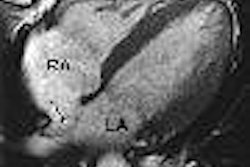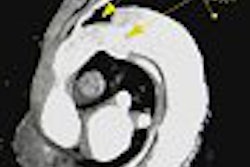SAN FRANCISCO - Whether they travel a few blocks or several miles, most patients would prefer to avoid multiple visits to various physicians. At the Nashville Cardiovascular Magnetic Resonance Institute in Tennessee, a patient referred for a cardiac MR (CMR) test is pretty much guaranteed that he or she won't be out of life's loop for more than a day.
In fact, within an hour of a scan, a patient will most likely find herself back in the doctor's office, said Dr. Dipan Shah during a presentation Sunday at the Society for Cardiovascular Magnetic Resonance (SCMR) meeting.
"One of the reasons for our success is that physicians like the fact that ... on the same day that (patients) have the MRI study, they can see the patient, and make management decisions in a short time period," explained Shah, the director of the Nashville center and a consulting associate professor of medicine at Duke University in Durham, NC.
Happy referring physicians and patients means steady referrals and higher volume, two things the center has achieved in a mere 18 months. During his SCMR talk, Shah outlined the elements that have contributed to the center's productivity and popularity.
Background
The Nashville center was opened in June 2003. It's an outpatient facility that is part of a large cardiology group practice. It has one 1.5-tesla scanner (Magnetom Sonata, Siemens Medical Solutions, Malvern, PA).
At the time of opening, there was one physician on staff (Shah), two RTs, and one nurse, Shah said. Currently, the center is staffed by three doctors, three RTs, and three nurses.
"Let me just give you an idea about our volumes," Shah said. "In our first month, we performed 53 CMR studies. If you look at our last month, we're up to 150 or so. There's been a steady, progressive growth over this 18-month period of time."
On a daily basis, the center went from fewer than four cases a day to eight to 10 cases a day. Initially, the majority of the scans were vascular exams (about 60%, according to Shah) with the remaining 40% devoted to cardiac. That case mix has since reversed, with the center performing more cardiac exams.
"What's most striking is the volume of stress cases, which went from 7% up to a third of all cases that we do," he added. "Stress cases certainly take the longest, but I think that's where there is the greatest need."
Preprocedure
The exam begins before the patient steps foot in the center. Shah created an order sheet that referring physicians are required to fill out. In addition to including the standard patient information (clinical history, reason for study), the order sheet includes a list of contraindications.
"I want to make people tune in to (contraindications)," Shah said. "A lot of the people referring for CMR studies are cardiologists or cardiac surgeons who probably have limited experience using MRI. Just by having this prompt on the sheet itself, we try to avoid scheduling patients who can't be scanned because of contraindications."
The order request also includes a list of the various studies that can be performed with CMR, once again alerting referring doctors to the options that they have. "We make them aware of all the things that CMR can do," Shah said.
Next, the patient is given an information brochure that explains the basics of the imaging procedure. The night before the exam, a nurse reviews the order form and charts, and checks in with the patient, going over the details of the exam. The patient is asked to arrive at least an hour before the scheduled exam time.
The phone call to the patient also gives the staff an opportunity to screen for claustrophobia and to suggest that the patient bring a driver along, especially if sedation will be required. Asking these questions and providing this information in advance can prevent aborted exams onsite.
"The biggest misconception that people have is that having a CMR study means they can drop in for a few minutes, get the test done, and leave. In fact, it's going to take longer than they think. Just by having them prepared in that proper mind-set, it improves the workflow," Shah said.
CMR procedure
"In our lab, we do a fair amount of imaging," Shah said. The protocol starts off with multiple cine images, followed by dark blood and bright blood morphologic images, and rest/stress perfusion.
"While we're waiting for the 10 minutes or so between stress and rest, we'll do some quick valve assessments, which can provide a basic assessment of myocardial inflow and left ventricular (LV) diastolic function," Shah explained. After rest perfusion testing is completed, the exam is finished off with two sets of viability images.
"One initial set are what we call single-shot, nonbreath-hold images, which are lower resolution, but provide an image of a single heartbeat," he said. "This is a way to have a complete assessment. Then we go on to the gold standard -- breath-hold, inverted-recovery gradient-echo images."
Postprocedure
A key element to the center's success is on-the-spot analysis of the images, Shah said. A duo of RTs tag team the study, with one RT performing the scan, while the other is at a second workstation processing the cases as imaging takes place. "Because they learn the software and system very well, a significant amount of postprocessing is done by the time the patient leaves the scanner," he added.
Shah or another physician then sits at a third workstation, reviewing the images. Postprocessing includes LV volumes, LV mass, ejection fraction, flow analysis, and 3D MIP for vascular studies, he said.
Relaying the results
Test results are generated using an automated system, Shah said. This negates the need for dictation or proofreading.
"The report is generated instantly," he stated. "I can quickly send a text page to the ordering physician to give them a summary of what the findings are. We also have a Web-based system where the physician can review the images from any facility that he is at via our network."
In response to an SCMR audience member question, Shah said he believed this reporting system is HL7-compatible and can exchange information with a RIS.
A matter of time
Time is money, and Shah pointed out that one issue to take note of is exam turnover time.
"I think (turnover time) is important and often overlooked ... (that is) the time between when the last image is taken on the first patient and the first image is taken on the next one," he said. Shah has tracked the turnover time since the center opened. During the first month, the turnover time ran about 31 minutes. His team now has that down to a tight 15 minutes per case.
"So if we do eight studies a day, that means we get done two hours earlier, or it means we can get a couple extra cases out," he said.
Shah also tracked overall scan times between the first and more recent month of operation, and found that practice really does make perfect. Stress studies, which took one-and-a-half hours, are now done in less than an hour, he said. Viability studies are wrapped up in under 50 minutes compared to 80 minutes. Vascular studies used to require 56 minutes, and are now done in 34 minutes.
Additional improvements in scan time will come with technical advances such as hardware performance and parallel imaging techniques, as well as single-shot and real-time imaging.
Saving time in the long run will most likely mean investing time in personnel training early on. While offsite courses are available, Shah said that he did have to take the time to do in-house training with the RTs on the equipment, software, and postprocessing techniques.
"Ultimately, what you can learn in one week at a course is not the same as what you can actually learn hands-on," he said. "Overseeing the training process does take time upfront, but you'll save time down the road. There are advantages to doing one thing over and over again. Your entire system becomes more efficient because everyone learns to work well together."
By Shalmali Pal
AuntMinnie.com staff writer
January 25, 2005
Related Reading
Automated report tracking serves clinical, educational goals, January 28, 2005
Information life cycle management: A prescription for the healthcare industry, December 31, 2004
Making the most of CT technology through efficient workflow, June 28, 2004
Copyright © 2005 AuntMinnie.com


.fFmgij6Hin.png?auto=compress%2Cformat&fit=crop&h=100&q=70&w=100)





.fFmgij6Hin.png?auto=compress%2Cformat&fit=crop&h=167&q=70&w=250)











